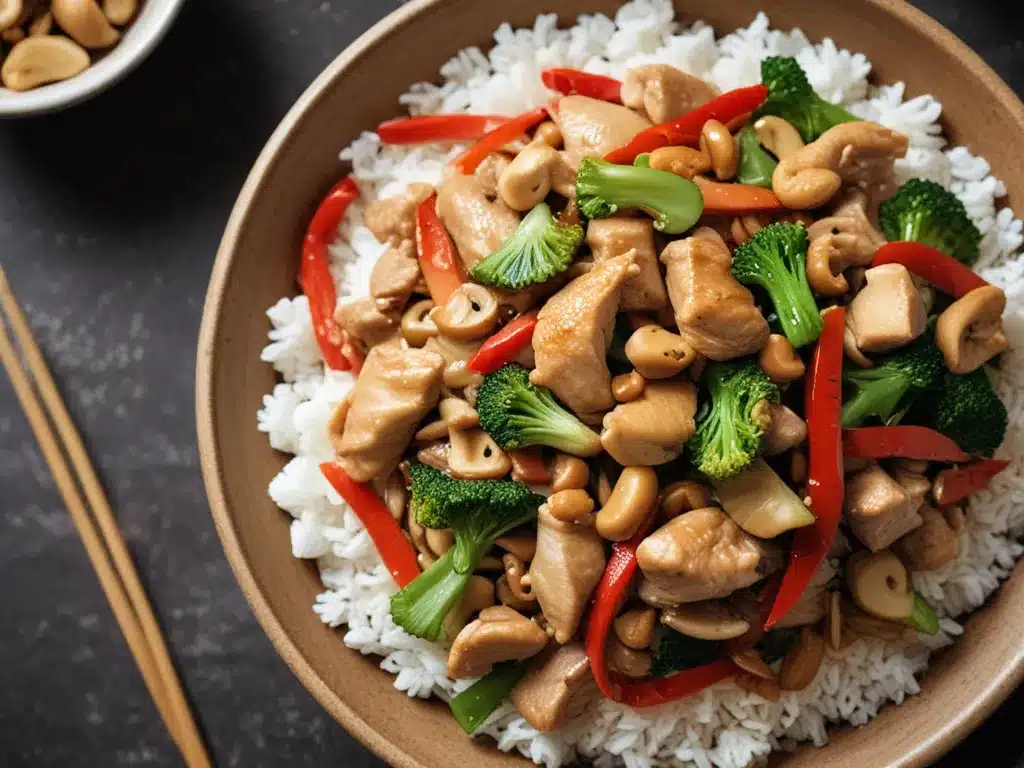
Ingredients for Chicken and Cashew Stir Fry
As I was planning to make chicken and cashew stir fry, I took stock of the key ingredients needed. The main proteins are chicken breasts cut into bite-sized pieces and roasted cashews. For aromatics and flavor enhancement, I chose minced garlic, fresh ginger, and green onions. Soy sauce provides savory umami taste, while rice vinegar adds a bit of acidity and balances the flavors. Cornstarch is used as a thickening agent to coat the chicken. Vegetable or peanut oil is needed for stir-frying. Other optional ingredients include baby corn and carrots for color and texture.
Preparing the Chicken and Cashews
The first step is to prepare the main ingredients – chicken and cashews. I cut the chicken breasts into 1/2-inch cubes. I then tossed them with 1 teaspoon of cornstarch to lightly coat. This helps the chicken remain tender and prevents it from drying out during cooking. For the cashews, I simply roasted them in a dry pan over medium heat for 2-3 minutes until fragrant and lightly toasted.
Next, I minced the garlic and ginger. The ginger adds warmth and spicy notes to balance the sweetness from soy sauce and chicken. I also sliced the green onions on an angle into 1-inch lengths for garnishing later. With the main components ready, I could then focus on cooking everything together in the wok.
Cooking the Stir Fry
To cook the stir fry, I first heated my wok over high heat and swirled in 1 tablespoon of vegetable oil. Once the oil was hot and slightly smoking, I added the chicken pieces in a single layer. I let them cook undisturbed for 2 minutes to develop some browning before stirring. Constantly stirring helps ensure even cooking and prevents burning.
After 2-3 minutes total, the chicken was almost fully cooked through. I then added the minced garlic and ginger and stirred constantly for 15-30 seconds to release their aromatic flavors but not burn them. Next, I poured in the roasted cashews, baby corn, and carrots (if using) and continued cooking while stirring for another 2 minutes.
Lastly, I lowered the heat to medium and added 1-2 tablespoons each of soy sauce and rice vinegar. I tosssed to coat everything evenly before letting the sauce simmer and thicken for 1 minute. The stirred dish was then ready to be served immediately over rice, garnished with sliced green onions.
Personal Experience Making Stir Fry
Having made chicken and cashew stir fry many times before, I am always excited by the variety of flavors and textures it offers with relatively few ingredients. One time, I decided to add cubed pineapple to the dish on a whim. The natural sweetness of pineapple complemented the salty, savory flavors beautifully. I was surprised by how well the flavors blended together harmoniously.
Another time, I experimented with substituting dark soy sauce in place of light soy sauce. The darker soy sauce imparted a richer, slightly molasses-like tint and taste. While unconventional, it was an interesting twist on the classic recipe. I have also used chicken thighs in place of breasts before to add more juiciness and succulence to the dish. No matter the variations I try, this stir fry never fails to be a crowd-pleasing weeknight mealfavorite in my home.
Comparing Homemade to Restaurant Version
| Ingredient/Aspect | Homemade Version | Restaurant Version |
|---|---|---|
| Chicken | Very tender and moist from quick cooking | Sometimes dry or tough if overcooked |
| Sauce | Sweeter and lighter from using less soy sauce | Saltier and darker brown from using more soy sauce |
| Texture | Individual chicken and vegetable pieces remain distinct | Ingredients are blended together more from constant stirring |
| Portion Size | Serves 3-4 as a main dish | Larger portions as part of a multi-course meal |
| Presentation | Simply plated on a single plate | Elaborately presented on a large platter |
As the table shows, there are some key differences between a homemade chicken and cashew stir fry versus one ordered at a restaurant. I find that cooking it myself allows for adjusting flavors more to personal taste. It also ensures the chicken is moist and tender. However, restaurants do excel at presentation and portion sizes optimized for a full dining experience. Overall, both versions offer tasty ways to enjoy this classic Cantonese dish.






